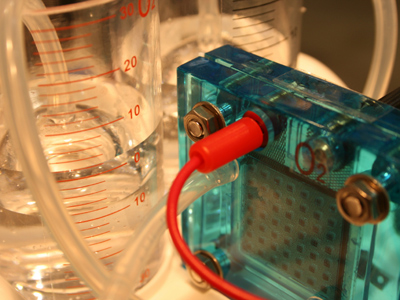Electrolysis is a process you need to be familiar with in high school Chemistry, and this is the first of two quizzes on the subject. In electrolysis ionic compounds are broken down. It is essential for your exam that you know at least the basic definitions (electrolyte, electrode, anode, cathode, ionic compound, anion, cation) and can recognize diagrams showing electrolysis. You should be able to work out what is produced at each electrode from the starting material - you don't need to learn each and every electrolysis, knowing a few simple principles such as the reactivity series will help you work things out from 'scratch'.
Electrolysis is carried out by dipping two electrodes connected to a DC supply into a solution of an electrolyte or a molten electrolyte. One electrode is attached to the negative side of the power source and the other to the positive side.
In industry, electrolysis is used in many ways. One of the favorites of the examiners is the production of aluminum so learn the Hall-Heroult process well. Other examples of real life electrolysis are the production of sodium hydroxide and chlorine by the electrolysis of brine, and the refining of the metal copper. If you know the principles of electrolysis plus these examples, you should cope easily with any questions that you come across.
The key to understanding what is happening during electrolysis is to remember two basic facts - one is about electricity, the other is about chemical bonding. Firstly, keep in mind that electricity is a flow of electrons pumped round a circuit in one direction by a power supply (e.g. power pack, battery) and secondly, ionic bonding involves the loss and gain of electrons.
Opposite electrical charges attract one another so the positive ions in the electrolyte move towards the negative electrode and vice-versa. Positive ions are called cations and so the negative electrode is called the cathode because it attracts the cations. The positive electrode attracts the anions and is therefore called the anode. During electrolysis in solution, oxygen is usually produced at the anode as anions are very stable.
When a cation reaches the cathode, one or more electrons are transferred to the cation, canceling out its positive charge. Most cations are metals so when they gain an electron, they become metal atoms and are deposited on the cathode. What happens then depends on the reactivity of the metal and whether the electrolysis is being carried out in solution or using a molten electrolyte.
If the electrolysis is being carried out in solution, hydrogen will be produced if the metal in solution is higher in the reactivity series e.g. sodium, potassium. Less reactive metals will form a deposit on the cathode and, as the thickness of the deposit increases, some of the deposit will flake off and be seen on the bottom of the electrolysis vessel. In a molten solution, where water is not present, the metal atoms are always produced - this is how reactive metals like sodium and potassium are extracted from their ores.
Have a go at this quiz and see how well you understand the electrolysis of ionic compounds








